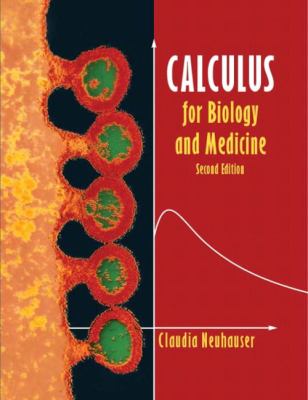190029
9780130455161
Calculus for Biology and Medicine
by Neuhauser, Claudia
About this item
- Condition: Good
- Provider: gotextbooks sales Contact
- Provider Rating: 54%
- Ships From: Little Rock, AR
- Shipping: Standard
- Comments: Used books are NOT guaranteed to contain components and/or supplements such as: Access Codes or working CD's/DVD's! Ships fast! Expedited shipping 1-3 business days; Standard shipping 7-14 business days. Ships from USA!

About this item
- Condition: Good
- Provider: GoTextbooks Contact
- Provider Rating: 74%
- Ships From: Little Rock, AR
- Shipping: Standard
- Comments: Used books are NOT guaranteed to contain components and/or supplements such as: Access Codes or working CD's/DVD's! Ships fast! Expedited shipping 1-3 business days; Standard shipping 7-14 business days. Ships from USA!

Product details
- ISBN-13: 9780130455161
- ISBN: 0130455164
- Edition: 2
- Publication Date: 2003
- Publisher: Prentice Hall
AUTHOR
SUMMARY
When the first edition of this book appeared three years ago, I immediately started thinking about the second edition. Topics absent from the first edition were needed in a calculus book for life science majors: difference equations, extrema for functions of two variables, optimization under constraints, and expanded probability theory. I also wanted to add more biological examples, in particular in the first half of the book, and add more problems (the number of problems in many sections doubled or tripled compared with the first edition). Despite these changes, the goals of the first edition remain: To model and analyze phenomena in the life sciences using calculus. do a traditional calculus course, biology students rarely see why the material is relevant to their training. This text is written exclusively for students in the biological and medical sciences. It makes an effort to show them from the beginning how calculus can help to understand phenomena in nature. This text differs from traditional calculus texts.First,it is written in a life science context; concepts are motivated with biological examples to emphasize that calculus is an important tool in the life sciences. The second edition has many more biological examples than the first edition, particularly in the first half of the book.Second,difference equations are now extensively treated in the book. They are introduced in Chapter 2, where they are accessible to calculus students without a knowledge of calculus and provide an easier entrance to population models than differential equations. They are picked up again in Chapters 5 and 10, where they receive a more formal treatment using calculus.Third,differential equations, one of the most important modeling tools in the life sciences, are introduced early, immediately after the formal definition of derivatives in Chapter 4. Two chapters deal exclusively with differential equations and systems of differential equations; both chapters contain numerous up-to-date applications.Fourth,biological applications of differentiation and integration are integrated throughout the text.Fifth,multivariable calculus is taught in the first year, recognizing that most students in the life sciences will not take the second year of calculus and that multivariable calculus is needed to analyze systems of difference and differential equations, which students encounter later in their science courses. The chapter on multivariable calculus now has a treatment of extrema and Lagrange multipliers. This text does not teach modeling; the objective is to teach calculus. Modeling is an art that should' be taught in a separate course. However, throughout the text, students encounter mathematical models for biological phenomena. This will facilitate the transition to actual modeling and allows them to see how calculus provides useful tools for the life sciences. Examples.Each topic is motivated with biological examples. This is followed by a thorough discussion outside of the life science context to enable students to become familiar with both the meaning and the mechanics of the topic. Finally, biological examples are given to teach students how to use the material in a life science context. Examples in the text are completely worked out; steps in calculation are frequently explained in words. Problems.Calculus cannot be learned by watching someone do it. This is recognized by providing the students with both drill and word problems. Word problems are an integral part of teaching calculus in a life science context. The word problems are up to date; they are adapted from either standard biology texts or original research. Many new problems have been added to the second edition. Since this text is written for c911ege freshmen, the examples were chosen so that no formal training in biology is needed. Technology.The book takes advantage of graphing caNeuhauser, Claudia is the author of 'Calculus for Biology and Medicine', published 2003 under ISBN 9780130455161 and ISBN 0130455164.
[read more]


